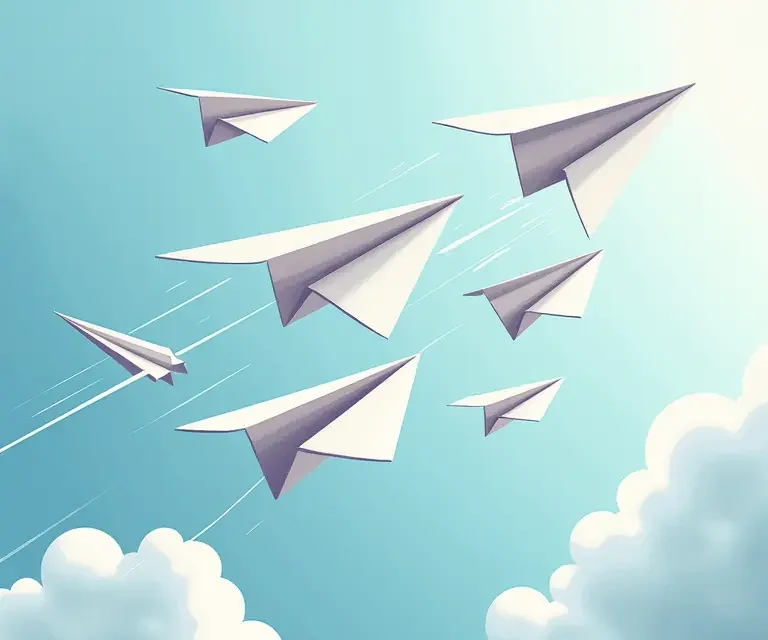For generations, the humble paper airplane has been a source of amusement, a quick classroom distraction, and a surprisingly elegant demonstration of fundamental physics. Beyond the simple act of folding and launching, lies a rich tapestry of aerodynamic principles, material science, and even a little bit of artistry. This article will delve into the surprisingly consistent physics governing these airborne creations, exploring how form dictates function, and why a seemingly simple design can achieve sustained flight.
The Four Forces of Flight
At the heart of every flying object, from a jumbo jet to a paper dart, are four fundamental forces: lift, weight, thrust, and drag. Understanding these forces is key to understanding how paper airplanes fly – or don’t fly!
- Lift: The upward force that opposes gravity. It’s generated by the shape of the wings as air flows over them.
- Weight: The force of gravity pulling the airplane down. This depends on the mass of the paper airplane.
- Thrust: The force that propels the airplane forward. In the case of a paper airplane, this is the force you impart when you throw it.
- Drag: The force that opposes motion through the air. It’s caused by air resistance.
For a paper airplane to fly successfully, lift must be greater than weight, and thrust must overcome drag. The design of the airplane, particularly the wings, is crucial in maximizing lift and minimizing drag.
Aerodynamics in Action: The Wing’s Role
The shape of a paper airplane wing – typically slightly curved on top and relatively flat on the bottom – is designed to create a difference in air pressure. As air flows over the curved upper surface, it has to travel a longer distance than the air flowing under the flatter lower surface. To meet at the trailing edge of the wing at the same time, the air above must speed up. Faster moving air has lower pressure, according to Bernoulli’s principle. This creates a pressure difference: lower pressure above the wing and higher pressure below. This pressure difference generates lift.
The angle of attack – the angle between the wing and the oncoming airflow – also plays a vital role. Increasing the angle of attack increases lift, up to a point. Beyond a critical angle, the airflow separates from the wing, causing a stall and a sudden loss of lift.
Paper Choice and its Impact
While seemingly trivial, the type of paper used significantly affects a paper airplane’s performance.
- Weight: Heavier paper (e.g., cardstock) creates a heavier airplane, increasing weight and requiring more lift. This can lead to faster, more stable flight, but shorter distances.
- Thickness: Thicker paper provides more rigidity, helping the airplane maintain its shape during flight. However, it can also make folding more difficult.
- Surface Texture: Smoother paper reduces drag, allowing the airplane to glide more efficiently.
Standard printer paper (20 lb) is a good starting point, offering a balance between weight, thickness, and foldability. Experimenting with different types of paper is a great way to explore how material properties influence flight characteristics.
Common Paper Airplane Designs & Their Physics
Let’s examine some popular designs and the physics behind their performance:
The Basic Dart
This is the classic, most recognizable paper airplane. Its narrow wings and pointed nose minimize drag, allowing for fast, straight flight. The relatively small wing area requires a strong throw to generate sufficient lift. The dart’s stability comes from its symmetrical design and the forward center of gravity created by the pointed nose.
The Glider
Gliders typically have wider wings and a more blunt nose. The larger wing area generates more lift, allowing for slower, more sustained flight. However, the increased surface area also increases drag. Gliders are often more susceptible to wind disturbances. This design prioritizes lift over speed.
The Stealth Bomber
This design, often characterized by swept-back wings, aims to reduce drag and increase stability. Swept wings delay the onset of compressibility effects at higher speeds (though this isn’t usually a factor with paper airplanes!). The wider wing span and carefully balanced weight distribution contribute to a stable gliding flight.
Controlling Flight: Ailerons, Rudders & Elevators (Paper Airplane Style)
Just like real airplanes, paper airplanes can be controlled by manipulating airflow over the wings and tail. We can create rudimentary control surfaces using small folds.
- Ailerons: Small flaps on the trailing edges of the wings. Bending one aileron up and the other down creates a roll, allowing the airplane to turn.
- Rudder: A vertical flap on the tail. Bending the rudder to one side causes the airplane to yaw (turn its nose left or right).
- Elevators: Small flaps on the trailing edge of the horizontal stabilizer (tail). Bending both elevators up causes the airplane to pitch up, increasing lift and potentially leading to a stall. Bending them down causes the airplane to pitch down.
Experimenting with these folds allows you to fine-tune the airplane’s flight path and achieve different maneuvers.
The Importance of Symmetry and Balance
Symmetry is paramount in paper airplane design. Asymmetrical wings or an off-center fold can cause the airplane to veer to one side or spin uncontrollably. The center of gravity (CG) also plays a crucial role. The CG should be slightly forward of the center of lift. If the CG is too far forward, the airplane will be stable but may not glide well. If it’s too far back, the airplane will be unstable and prone to stalling. Proper folding ensures symmetrical airflow and a balanced CG.
Beyond Flight: The Art & Science of Folding
The act of folding itself is a fascinating blend of geometry and engineering. Precise folds create crisp edges that define the airplane’s shape and influence airflow. The more accurate the folds, the more predictable the flight characteristics. The precision required in origami, for instance, mirrors the care needed for a high-performing paper airplane. Interestingly, the underlying principles of geometry found in paper folding also relate to the intricate formations of natural structures like snowflakes. See more about this in the geometry of snowflake formation.
Paper Airplanes and the History of Aviation
While paper airplanes may seem like a modern invention, their roots can be traced back centuries. Leonardo da Vinci sketched designs for ornithopters (flying machines with flapping wings) in the 15th century, and early experiments with gliders laid the groundwork for heavier-than-air flight. Paper models were often used to test aerodynamic concepts before building full-scale aircraft. The simplicity of paper airplanes makes them an accessible entry point into the world of aviation and aerodynamics.
Troubleshooting Common Flight Problems
- Airplane dives immediately: The center of gravity is too far forward. Try bending the trailing edges of the wings upward (elevators) or adding weight to the tail.
- Airplane stalls and falls: The angle of attack is too high, or the center of gravity is too far back. Reduce the angle of attack or add weight to the nose.
- Airplane veers to one side: The wings are asymmetrical, or the rudder is bent. Check for symmetry and straighten the rudder.
- Airplane doesn’t fly far: Not enough thrust or too much drag. Throw the airplane harder or streamline the design.
The Cultural Significance of Paper Airplanes
Beyond the scientific principles at play, paper airplanes hold a unique cultural position. They’re a symbol of childhood, ingenuity, and simple fun. Their ubiquity – found in classrooms, offices, and parks worldwide – speaks to their universal appeal. Like the early symbolism embedded within playing cards, paper airplanes hold a certain understated cultural weight. You can find out more about this in the symbolism of playing cards.
Paper Airplanes and the Broader World of Design
The principles learned from designing and flying paper airplanes translate to other areas of design. The emphasis on streamlining, weight distribution, and aerodynamic efficiency are all critical considerations in fields like automotive engineering, aerospace engineering, and even architecture. The careful considerations of rules and social order in historic boarding houses, for instance, are a different kind of design – a design for human interaction. Explore this further in the logic of boarding house rules.
The Unexpected Precision in Everyday Practices
The physics of a paper airplane, while seemingly simple, underscores a broader point: many everyday phenomena are governed by surprisingly consistent principles. The meticulous craft of historical barbering, for example, developed through a precise understanding of anatomy and aesthetics. Learn more about this in the history of barbering. Similarly, the science of food preservation, practiced for millennia, relies on a deep understanding of chemical reactions and microbial growth. See more on this in the science of food preservation.
Conclusion: Keep Folding, Keep Exploring!
The paper airplane is more than just a childhood pastime. It’s a dynamic demonstration of physics, a testament to the power of simple design, and a source of endless fun. By understanding the forces at play and experimenting with different designs, you can unlock the secrets of flight and create paper airplanes that soar. So, grab a sheet of paper, start folding, and let your imagination take flight!


 The Hidden Physics of Everyday Rhythms
The Hidden Physics of Everyday Rhythms  The Surprisingly Consistent Physics of Yo-Yo Tricks: From Ancient Greece to Modern Competition
The Surprisingly Consistent Physics of Yo-Yo Tricks: From Ancient Greece to Modern Competition  The Curious Physics of Bubbles: More Than Just Soap & Air
The Curious Physics of Bubbles: More Than Just Soap & Air  The Unexpected Physics of Play: How Toys Teach Us About the Universe
The Unexpected Physics of Play: How Toys Teach Us About the Universe